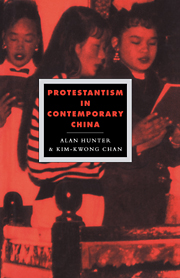Book contents
- Frontmatter
- Contents
- List of figure and tables
- General editors's preface
- Acknowledgements and notes on the text
- List of abbreviations
- Map
- Introduction
- 1 The social and political context
- 2 A survey of the Protestant community
- 3 The historical legacy
- 4 Protestantism and Chinese religious culture
- 5 Varieties of Christian life
- 6 Buddhism and Catholicism
- 7 Into the 1990s
- Bibliography
- Index
6 - Buddhism and Catholicism
Published online by Cambridge University Press: 04 May 2010
- Frontmatter
- Contents
- List of figure and tables
- General editors's preface
- Acknowledgements and notes on the text
- List of abbreviations
- Map
- Introduction
- 1 The social and political context
- 2 A survey of the Protestant community
- 3 The historical legacy
- 4 Protestantism and Chinese religious culture
- 5 Varieties of Christian life
- 6 Buddhism and Catholicism
- 7 Into the 1990s
- Bibliography
- Index
Summary
BUDDHISM IN THE 1980S
The fate of Buddhism between 1949 and the start of the Cultural Revolution has been documented by Holmes Welch, to whose work the reader should refer. To summarize, in the early 1950s the CCP organized a new Buddhist organization known as the China Buddhist Association (CBA). As with the TSPM, its leaders were specifically chosen for their willingness to co-operate with the CCP; it was rumoured that some of them were underground Party agents. Understandably this caused resentment among other Buddhist leaders, who felt the new organization was unrepresentative and too politicized. Government agencies implemented a programme of control and consolidation of Party leadership in religious circles. Many monasteries had been important landholders, and subsidized their activities by income from rent and corvées. The loss of property in the land reforms of the early 1950s led to the collapse of their economic structure. Many monks returned to lay life, under pressure from cadres, through poverty, because their monasteries were closed, or through choice. Some were sent to labour camps, many were maltreated, others executed. Buddhist publications were obliged to change their contents to support the Party line rather than preach orthodox Buddhism. Lay believers were too frightened to visit temples. With increasing speed the whole Buddhist establishment crumbled.
By 1966 only a few monasteries survived: they had been kept alive that long only because the government used its ‘tolerance’ of Buddhism as a diplomatic tool when dealing with Asian neighbours such as Burma, and to keep Taiwan out of international organizations.
- Type
- Chapter
- Information
- Protestantism in Contemporary China , pp. 219 - 256Publisher: Cambridge University PressPrint publication year: 1993



